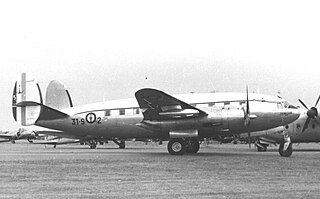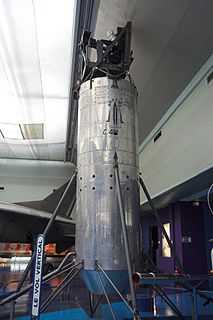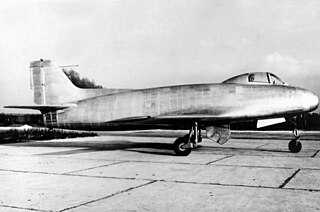SNCAC was a French aircraft manufacturer created by the nationalisation of the Farman Aviation Works and Hanriot firms in 1936.

The Farman F.220 and its derivatives were thick-sectioned, high-winged, four engined monoplanes from Farman Aviation Works. Based on the push-pull configuration proven by the F.211, design started in August 1925 and the first flight of the prototype was on 26 May 1932. The definitive F.222 variant was the biggest bomber to serve in France between the world wars. One variant was designed as an airliner.

The Nord 1500 Griffon was an experimental ramjet-powered interceptor aircraft designed and built by French state-owned aircraft manufacturer Nord Aviation. The Griffon was developed to become a Mach 2 follow on to the supersonic Nord Gerfaut research aircraft. Development of the aircraft began in earnest after the receipt of a letter of intent in 1953 for a pair of unarmed research aircraft. The design featured an innovative dual propulsion turbojet-ramjet configuration; the former being used to takeoff and attain sufficient speed to start the latter.

The Saab 21R was a Swedish fighter/attack aircraft developed and produced by Svenska Aeroplan AB (SAAB). It was a jet-powered development of the piston-engined SAAB 21 and was the first jet aircraft to be produced by Saab. The R-suffix stands for reaktion (reaction), referencing reaktionsdrift or reaktionsmotor. Along with the Soviet Yakovlev Yak-15, the 21R was one of only two jet fighters to have been successfully converted from piston-powered aircraft.

The SNCAC NC 1080 was a French jet-engined interceptor developed in the late 1940s by SNCAC for use aboard aircraft carriers. It was intended to compete for an Aéronavale contract and first flew in 1949. The aircraft used an innovative system of flight control surfaces that proved to be a failure during flight testing and had to be modified before it could fly again. Its development was troubled by other design flaws and the company's merger with SNCAN that same year. Further development was cancelled after a fatal crash destroyed the sole prototype in 1950.

The Arado Ar 96 was a German single-engine, low-wing monoplane of all-metal construction, produced by Arado Flugzeugwerke. It was the Luftwaffe's standard advanced trainer during World War II.

The Sud-Ouest S.O.30 Bretagne was a 1940s French airliner built by Sud-Ouest.
The Arsenal VB 10 was a French fighter-interceptor aircraft developed during and shortly after World War II. It was a low-wing monoplane with retractable tailwheel undercarriage and of largely orthodox configuration. The ultimate product of a design that began with the Arsenal VG 10 prior to the war, the VB 10 added a second engine behind the cockpit which drove a second propeller, coaxial with and contra-rotating to the propeller driven by the engine in the nose.

The Arsenal VG 90 was a French carrier-based jet-engined interceptor developed in the late 1940s. It was intended to compete for an Aéronavale contract and first flew in 1949. It set a speed record for a French aircraft the following year, but both of the completed prototypes were destroyed in fatal crashes and the program was cancelled in 1952 before the third prototype was finished. The Aéronavale contract was eventually awarded to a license-built British aircraft. The remains of the last VG 90 were scrapped in 1978.

The SNECMA Atar Volant or C.400 P1 was a French turbojet engine produced by SNECMA as part of their "Atar" series. Encased in a basic fairing which could hold fuel and remote-control equipment, the unit weighed 5,600 pounds (2550 kg) and generated a thrust of approximately 6,200 pounds-force ; the Atar Volant was able to cause vertical lift, which was precisely its purpose. There were later Atar Volant models, each made improvements and alterations to the previous designs, and eventually resulted in a full-fledged craft.

The Sud-Ouest SO.6000 Triton was an early experimental French jet aircraft. It has the distinction of being the first indigenously-designed jet-powered aircraft to be flown by the nation, having been designed and manufactured during the 1940s by the French aircraft construction consortium SNCASO.

The SNCAC NC.211 Cormoran was a large four-engined military transport aircraft for passengers and cargo designed and built by SNCAC from 1945.

The SIPA S.200 Minijet was a light sporting jet aircraft designed and produced by the French aircraft manufacturer Société Industrielle Pour l’Aéronautique (SIPA). It is designed to perform liaison, training, and aerobatic flights. The Minijet was claimed to be the first jet-powered light touring aircraft

The Nord 2200 was a French carrier-based, jet-engined interceptor developed in the late 1940s. It was intended to compete for an Aéronavale contract, but was not selected for production after a 1950 accident badly damaged the sole prototype. It was repaired and resumed flight testing the following year, which including evaluating rocket-assisted take offs. After the aircraft made its last flight in 1954, it was used as a gunnery target. Much of the airframe was recovered in the 1980s, but its current disposition is uncertain.

The SNCASO SO.9000 Trident was a French mixed-power interceptor aircraft built by aircraft manufacturer SNCASO during the 1950s. As part of a wider effort to re-build French military power during the late 1940s and to furnish France with advanced, new domestically produced designs, a request for a supersonic-capable point-defence interceptor aircraft to equip the French Air Force was issued to SNCASO. In response, the firm designed the mixed-propulsion Trident, powered by a single SEPR rocket engine, which was augmented by wingtip-mounted turbojet engines, and the Air Force ordered two prototypes.
The Arsenal-Delanne 10 was an experimental fighter aircraft of French origin. The plane had a rear cockpit and a distinctive tandem wing.

The Bernard H.V.120 was a 1930s French racing seaplane designed and built by Bernard to compete in the Schneider Trophy race. Delays caused by engine problems and the crash of the second aircraft delayed entry and the aircraft did not race in the competition.

The SNCAC NC-600 was a prototype French twin-engined long-range fighter aircraft, developed by SNCAC from the earlier Hanriot H.220 fighter. The type never entered service, with development being ended by the French surrender in June 1940.

The SNCAC NC.2001 Abeille was a single engine, twin intermeshing rotor helicopter designed and built in France in the late 1940s. Three were completed but only one flew, development ending when SNCAC was closed.
The SNCAC NC.271 was a French experimental aircraft built by SNCAC in the late 1940s, as a 1:2.5 scale model of the proposed SNCAC NC.270 jet bomber, featuring swept-back wings, using SNCASE SE-161 Languedoc N0.31 F-BCUT as a launch platform.
















